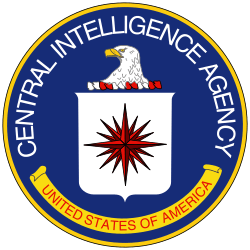CIA activities in the United Kingdom
There is a long history of close cooperation between the United States and the United Kingdom intelligence services; see Clandestine HUMINT and Covert Action for World War II and subsequent relationships. There are permanent liaison officers of each country in major intelligence agencies of the other, such as CIA and Secret Intelligence Service ("MI6") (which is the British counterpart of the CIA), FBI and the Security Service (MI5), and National Security Agency (NSA) and Government Communications Headquarters (GCHQ).
Oleg Penkovsky, a Soviet military intelligence colonel, who was a defector in place, was a joint US-UK espionage operation. Much of Penkovsky's product is available online at the CIA FOIA Reading Room under the code name IRONBARK.[1]
A major source of tension between the two countries was Kim Philby, a senior UK SIS officer who was a Soviet agent. Philby, at one point, was the SIS liaison officer resident in the US. James Jesus Angleton, head of CIA counterintelligence, was surprised by Philby's activity, and, as a consequence, began hunts for moles within CIA.
United Kingdom 1999
Counterintelligence
An indication of the United States' close operational cooperation is the creation of a new message distribution label within the main US military communications network. Previously, the marking of NOFORN (i.e., NO FOREIGN NATIONALS) required the originator to specify which, if any, non-US countries could receive the information. A new handling caveat, USA/AUS/CAN/GBR/NZL EYES ONLY, used primarily on intelligence messages, gives an easier way to indicate that the material can be shared with Australia, Canada, the United Kingdom, and New Zealand. This marking is now used as FVEY or Five Eyes.[2] There is also a marking for US/UK access only, which is "REL TO USA, GBR."
United Kingdom 2004
Counter-terrorism
In his early 2005 testimony to the Senate Intelligence Committee, Porter Goss mentioned that in 2004, the UK detected and dismantled an al-Qa'ida cell.[3]
See also
- 1953 Iranian coup d'état
- ISI activities in the United Kingdom
References
- CIA FOIA - Overview
- US Defense Information Services Agency (19 March 1999), DMS [Defense Messaging Service] GENSER [General Service] Message Security Classifications, Categories, and Marking Phrase Requirements Version 1.2 (PDF)
- Goss, Porter (16 February 2005), Global Intelligence Challenges 2005, archived from the original on 2008-12-02
